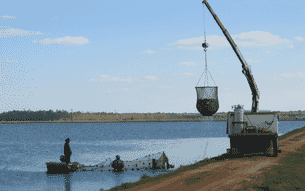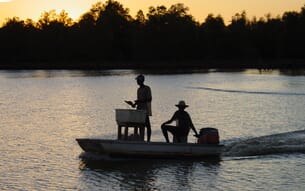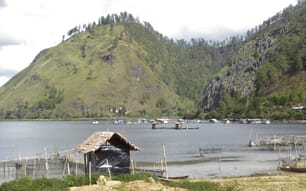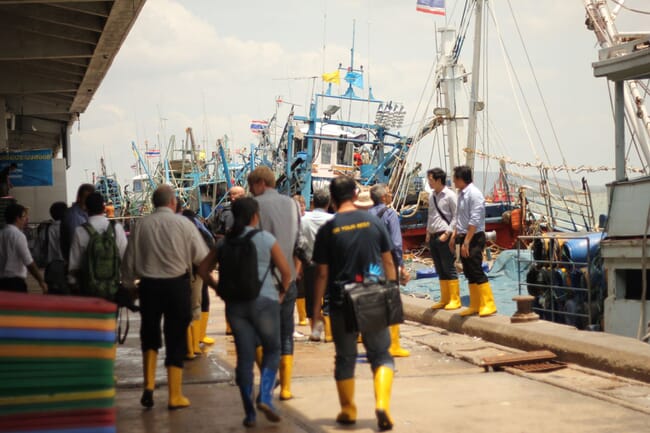
© SFT
In the first installment of a new column for The Fish Site, World Wildlife Fund’s Aaron McNevin, who is the environmental co-chair of the Seafood Task Force’s group of external stakeholder advisors (ESA), explains the significance of the initiative and how he would like to see it evolve – both in Thailand and beyond.
Background
In June 2014 I was living in Surat Thani, Thailand attempting to remove some roadblocks to Aquaculture Stewardship Council (ASC) shrimp certification for one of WWF’s corporate partners. One of these barriers was the identification of the fishery(s) producers were using for the fish meal source in shrimp feed. It was difficult to gain any insight into the feed supply chains for raw material origin, and I had concluded that I would not be able to deliver on the agreement with our partner. As the disappointment sank in, a horrifying story was released by The Guardian on 10 June 2014 detailing forced and bonded labour in the shrimp feed supply chains – most notably on the Thai-flagged trawling vessels operating in the Gulf of Thailand and the Andaman Sea.
Not long after that article, I received a call from our corporate partner, and I was asked to get up to Bangkok and get ready because we were going to school, and the topic was shrimp feed supply chains in Thailand. We met at the headquarters of one of the main feed manufacturers and went through our step by step itinerary – from the Songkhla port where the Guardian article originated, to the shrimp processing plants in Samut Sakhon where shrimp is packaged for export. A couple of retailers, some Thai manufacturers, a couple of NGOs, and we were off.
Over the course of the last six years since the first meeting of that small group, which would come to be known as the Seafood Task Force (STF), there have been incredible challenges overcome, there are stories within stories of amazing efforts that Thai manufacturers have taken to fundamentally change the way seafood is procured and produced, and there are new norms originating that will likely apply to all seafood eventually. Through it all, the STF has sought to deliver supply chain oversight at scale so that trade in seafood can be conducted with confidence. As one of the external stakeholder advisors, I feel it is timely that I share my perspective on the STF. (As a disclaimer, my perspective is focused on shrimp and does not include the significant efforts underway on tuna supply chain oversight.)

© SFT
Connecting the dots
Early on, it was recognised that previous efforts to provide supply chain oversight had failed. Doubling down on those various ratings and programmes was not going to provide any greater confidence in the supply chain. Instead, a step-by-step track and trace protocol was developed with requirements for each node in the supply chain. This protocol was novel in that it sought to track fish from fishing ports through fish meal renderers, to feed companies, onward to shrimp farmers, and ultimately to the processors who would export the product.
Attempting to trace shrimp lots back to the fish used in feed lots was daunting. Between feed mills and farms were numerous feed wholesalers, and between farms and processors were numerous aggregators of shrimp. The solution came from feed manufacturers agreeing to stamp every feed bag with a lot number that corresponded to the fishmeal lot used in that feed. And at the other end of the supply chain, the processors were working with their traders and farmers to request that these lot numbers for feed be recorded and passed on with harvested shrimp. Ultimately, the STF manufacturers developed a Feed Information Form (FIF) that was included in every feed sale to farmers, which allowed for consistent reporting of feed lots alongside shrimp lots.
It should be apparent that the novelty of the solution was only part of the success; the other part was the pre-competitive collaboration across 75 percent of feed manufacturers and 80 percent of shrimp processing that delivered, for the first time, a shrimp aquaculture supply chain connected to the feed supply chain without any eco-label or special brand. This was one of the new norms.
Most efforts to establish traceability fail because reforms are attempted in a single supply chain where raw material providers can simply choose to sell product in another supply chain without those requirements. The more pre-competitive the collaboration, the less opportunity there is for leakage of raw material not meeting requirements.

© SFT
The STF had developed a system that could be applied to all aquaculture to connect feed and cultured product. Yet the volume of paperwork generated was overwhelming. The solution was a digital traceability system. The STF worked to develop a free and open source electronic traceability system where the only cost would be associated with cloud storage space, to avoid pricing small scale farmers out of it. The development of this prototype solution spurred Thailand’s Department of Fisheries to develop a similar electronic traceability system to track shrimp through the supply chain with an electronic Aquatic Purchasing Document (APD). The APD system will soon be mandatory for all supply chain actors involved in the trade of aquaculture products in Thailand. This system also provides the FIF for producers to populate, but at this time the FIF is only mandated by the STF for its members.
Intervention
The STF was able to identify all actors in member supply chains, and then it was necessary to implement protocols to protect against labour and human rights abuses and illegal, unreported, and unregulated (IUU) fishing. Labour recruiters were a major challenge in establishing responsible recruitment of migrant workers. Protocols were developed to establish “approved recruiters”, and a social code of conduct was developed and applied to all components of the supply chain. However, it would be impossible to audit every component of every single supply chain, so the STF brought a medical statistician to assist in developing a sound sampling protocol that the STF Secretariat could implement in member supply chains. This was a key moment because every other certification and oversight mechanism demands copious auditing, but the STF sought scale and required something different.
The STF was intervening in the way labour was procured and how labour was treated at different supply chain nodes through a sampling programme that would allow scaled oversight. Yet, the natural resources used in the aquaculture supply chain were not covered under the STF programme at that time. The inextricable linkages between social wellbeing and environmental sustainability are most pronounced in the case of the Thai seafood sector. The demise of the fisheries directly diminished the return on fishing effort for boat captains until it was no longer profitable to pay workers. With fisheries one of the primary natural resources the STF sought to protect, it enlisted the support of a technical NGO with a depth of experience in fisheries monitoring, control, and surveillance (MCS). This NGO was embedded in the Department of Fisheries to assist in developing a system for tracking vessel behaviour and determining if Thai law was being violated. Together they revamped the processes by which vessels were tracked and how to build the evidence needed to take cases to court for prosecution.

© STF
However, stopping IUU does not convey fishery sustainability, and the STF is continuing to develop its environmental code to protect fisheries and the other natural resources used in the production of shrimp. When the social and environmental codes are implemented together, they will form the basis of the membership benefits to both buyers and manufacturers – a cost-effective environmental and social oversight mechanism that is scalable. Furthermore, there is considerable discussion about the ways to bring down costs of duplicative auditing, so that manufacturers can reinvest that money into the supply chain for one of the greatest efforts – a no fee recruitment system that does not indenture workers to employers. Although not fully operational, the Thai manufacturers are taking a giant step out in front of other Thai industry players by going against the norms of migrant recruitment.
The way forward
Currently, the STF has revamped its requirements for membership, increasing accountability and penalising those that do not follow the rules. These new rules will make the STF one of the most trusted and influential seafood platforms globally. This new level of accountability will generate an even more involved set of supply chain actors that seek to use their purchasing power to improve conditions in seafood value chains. The STF has attracted philanthropic support because of their accomplishments to date, and they have recently received a large grant to expand their operations from Thailand to Vietnam, Indonesia, and India.
As the STF gets closer to the full deployment of their oversight mechanisms, it is important to recognise that everything mentioned in this article that the STF has done or accomplished has been imperfect. There has been an explicit sacrifice of perfection for the maintenance of progress. The STF will remain imperfect but continue to take on the greatest challenges in the sector without the gloss of other initiatives. This is because early in the development of the STF, it was agreed that the Secretariat of the STF would not conduct proactive communications. The premise was that the issues that the STF were dealing with were too important to be glossed over with sustainability speak and collective results would speak for themselves.
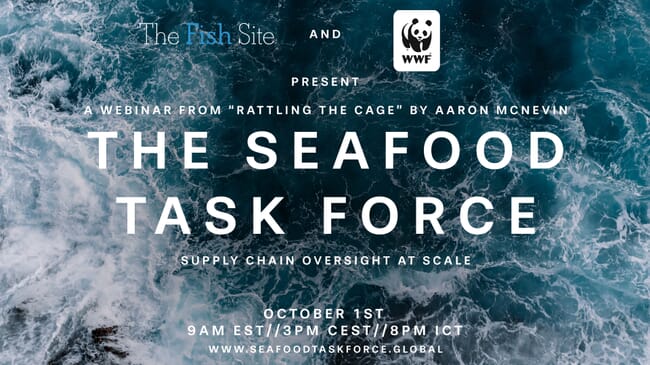
Making a change without making a splash
To find out more about the Seafood Task Force, please join The Fish Site and some of the key players in the initiative for an exclusive webinar at 2 pm (9 am EST, 3 pm CET) on 1 October, offering a rare glimpse into one of the most discreet platforms pushing sector-wide change in some of the most challenging seafood supply chains. The panel consists of members of the STF as well as several external advisors. Together, they will share their perspectives on why they became engaged in this effort, the successes and obstacles, and most importantly, why they remain engaged six years from inception.
Register for the webinar here.
Event details
Moderator:
- Rob Fletcher, senior editor, The Fish Site
Panellists:
- Alisa Phurkwattanagul, director of quality systems, Marine Gold Products Ltd
- Nuntawun Rujiwong, assistant to senior director, Thai Royal Frozen
- Aaron McNevin, global lead on aquaculture, WWF
- Lydia Long, director of programmes, Verité, Ethical Trade Initiative
- Laura Jungmann, lead sustainability, Albert Heijn

